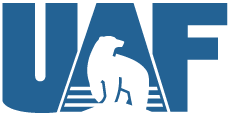Conducting hydrokinetic energy field work at TRTS

ACEP summer intern Lucian Rodriguez gives a presentation on his project.
September 23, 2025
Small microgrid communities in Alaska often. Hydrokinetic energy technologies may offer the potential to produce electricity and help reduce dependence on diesel fuel to power their diesel generators, resulting in electricity cost savings. Providing cleaner energy with hydrokinetic technologies may also help the communities with better air quality and less noise.
ACEP intern Lucian Rodriguez spent this summer working on hands-on aspects of hydrokinetic energy operations.
Rodriguez worked under the guidance of Stephanie Fisher and Leo Azizi, research professionals with ACEPтАЩs marine energy program, who manage field operations at the Tanana River Hydrokinetic Test Site, or TRTS. He immersed himself in the fieldwork, including metal fabricating, designing and installing solar systems, wiring and multibeam sonar testing.

ACEP summer intern Lucian Rodriguez sets up a base station to establish vertical and horizontal control of a known point.
RodriguezтАЩs main focus was designing and deploying an eight-stage auto bilge pump system housed on a debris-diverting floating structure. This system maintains constant water ballast in the eight separate compartments. This structure allows the diverterтАЩs submerged depth to be automatically adjusted and maintained based on present water velocity conditions, enabling the TRTS to safely test hydrokinetic devices without the imminent risk of uncontrolled debris such as large trees and tree debris damaging the devices, a constant threat in Alaskan rivers.
As he learned how to conduct hydrokinetic field work and operations, he was also exposed to specialized instrumentation. These included a multibeam imaging sonar, a global navigation satellite system (a network of satellites that provide positioning, navigation and timing services to users) and acoustic doppler current profilers (devices that use sound waves to measure the speed and direction of currents throughout the water column).
For Rodriguez, the internship offered plenty of opportunities to ask questions to more fully understand the ongoing projects. He enjoyed the hands-on aspect of his internship and working with a diverse group of professionals.
He learned not only skills associated with field work such as how to safely drive a boat and conduct field repair and maintenance of equipment, but he also improved the communication skills he needed to relay his ideas, solve problems under pressure and work in a team under real-world conditions. Collaborating with engineers also shed light on the unique challenges they face working in remote field situations.

ACEP summer intern Lucian Rodriguez and research professional Leo Azizi put a debris diverter in the water at the Tanana River Hydrokinetic Test Site.
тАЬWorking in the field taught me incredible skills that could never be learned in an office,тАЭ Rodriguez said.
This summer internship work inspired him to change his course of study in college. Rodriguez began his internship as an applied physics major at the University of California, Santa Cruz. He is now studying integrative design engineering with a focus on environmental engineering at University of Colorado Boulder.
This internship was funded by the U.S. through ACEPтАЩs Research Experiences for Undergraduates program. View the on ACEPтАЩs YouTube channel. For more information on this project, contact Stephanie Fisher at sjump@alaska.edu.


